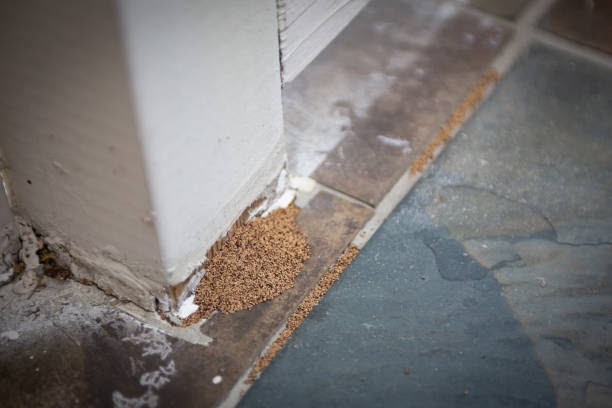
Have you ever got back home after work just to find small piles of wood dust under your sofa? This will almost always result in a termite infestation. Termite damage has become quite common in many households and it has become an extremely difficult problem.
Termites are difficult to eradicate because they are not identifiable until they have caused major damage and developed massive colonies. As a result, if termites have been discovered in your home, you must act quickly to protect yourself against them.
Because of the tiny size of termites, it’s quite difficult to get rid of them once they’ve penetrated your home and begun munching on the foundation of your home or your expensive belongings.
Regularly inspecting your home for termites and other pests can help you save a lot of time and money.
How to control termite damage: Top tips
Do you have any concerns about termite damage? Unfortunately, you’re not alone if this is the case.
Schedule a yearly pest control service with the termite treatment in New York City for termite services to examine your property and administer treatments as needed.
Every decade, termites infestations cause billions of dollars in structural damage, and homeowners spend approximately more than two billion dollars on termite treatment.
Here are some top tricks and tips you can use to keep termites from spreading and ensure a successful treatment:
Moisture is the enemy
It’s one of the reasons pests such as termites are drawn to your home. By reducing excess moisture from your property, termites can be kept at bay.
If you reside in a humid environment, a dehumidifier may be useful. During the summer, you can keep the air conditioner on and off throughout the day to keep the house cool and eliminate excess moisture.
Fix the leaks
Keep a watch on your home for any leaks or deterioration. Termites prefer termite-infested roofs and damp walls.
Varying materials shrink and expand at different rates over time, such as wood, metal, concrete, and PVC. This settling process may result in fractures and holes, which termites can use to gain access to your home.
Termites can infiltrate a structure through openings as small as 1/32nd of an inch. Therefore, you should seal them as soon as you see them.
Repair and fix leaks as soon as possible, and inspect your property often, particularly in basements and dark areas.
Even though these regions are typically overlooked, they are the first to attract pests. For example, a basement leak is especially tempting because it is closer to the ground, making termites simpler to attack.
Borate: a termite repellant
Spray the wood with borate before painting. It absorbs into the wood, preventing termites from chewing on it.
Then, after the termite spray has dried, prime and paint it as usual before using it to construct window frames, doors, and furniture. This borate spray will keep termites at bay for a long time.
Declutter your living space
Even if you’ve hired a natural pest control company to cure your home for termites or bed bugs, decluttering is essential.
Empty papers, cardboard, old magazines, and newspapers should be given special care. This is because they provide the perfect environment for pests to thrive.
If one of your rooms has been infested with termites, do this. Don’t move anything from that room, including furniture, to other parts of the house that aren’t afflicted.
Keep a safe gap between the dirt and the wood
Make sure that a certain amount of space separates the soil and the wood in a garden. The majority of specialists feel that a minimum of eighteen-inch space is required.
If you do this, termites will be less likely to attack your home’s foundation and furniture. Use stones or cement to separate soil from the wooded area to provide a physical barrier for termites, especially in patios, gardens, and other locations.
Place infected goods under the sun
Keep furniture under direct sunlight for at least three days if termites are causing damage. Because termites can’t stand the heat, summer is a wonderful time to employ this termite protection method.
Keep the furniture in the sun for heat to kill the termites and dry it out, lowering the likelihood of re-infestation. It’s a good idea to dust the furniture thoroughly and treat it with a termite repellant before reinstalling it in the house.
You may do the same thing to ensure that furniture that isn’t likely to be destroyed by termites stays termite-free.
Common FAQs
Q. Is using pesticide safe for termite damage?
The EPA must guarantee that the pesticide fulfills current safety requirements when used according to label recommendations to safeguard human health and the environment.
This was per the government agency in charge of regulating all pesticides marketed, applied, or distributed in the United States.
Therefore, we require more than 100 distinct scientific research and tests from applicants to make such conclusions. Most states also go over the pesticide label to meet federal labeling requirements and any additional state limitations.
Because many termiticides are highly hazardous, it’s especially important to observe label directions with caution. Pest management professionals have the essential knowledge, expertise, and equipment, reducing hazards and increasing efficacy.
Q.What if termites have already invaded your home?
If termites have already entered your home, the first step should be to call a pest control professional to do a thorough inspection, followed by termite treatment.
When you consider the damage termites may do to your home’s foundation and furniture, the cost of termite treatment will not appear extravagant.
In addition to the above methods, you may improve the condition of your home after the termite treatment by cleaning your furniture with oils such as neem oil regularly to keep termites at bay.
Final thoughts
While using this checklist can help protect your home from termites, it’s always a good idea to have your home inspected by a skilled termite technician once a year.
They should be able to find hidden points of entry and detect early signs of termite infestation in your home.
















